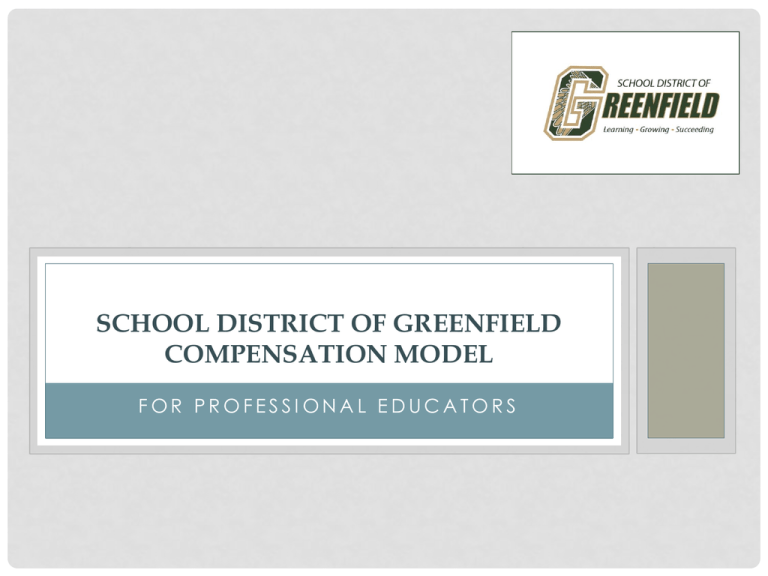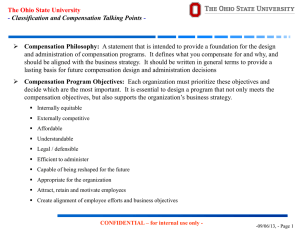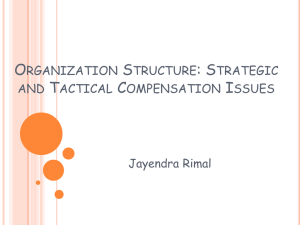here - School District of Greenfield
advertisement

SCHOOL DISTRICT OF GREENFIELD COMPENSATION MODEL FOR PROFESSIONAL EDUCATORS WHY A “NEW” COMPENSATION MODEL? • Since 1970s, salaries for teachers were formally bargained per state law • Under former state law, increases to teacher compensation needed to reach the Qualified Economic Offer (QEO) which was set at 3.8% • The QEO did not include advancement on the lanes/step system • So, aggregate teacher compensation often rose higher than 3.8% annually when lane/steps were considered, as well as benefit cost increases WHY A “NEW” COMPENSATION MODEL? • Beginning in 2011, revenue authority (state aid & local property tax) to school districts was significantly reduced. • For example, in 2008, the District was allowed to invest an additional $275 per resident student, compared to the year prior. • In 2013, that amount is $75 per resident student. • The District has 3021 resident pupils, thus a $200 reduction in revenue authority results in over a $600,000 reduction annually. WHY A “NEW” COMPENSATION MODEL? • In 2011, changes were made to state law. • Prohibits bargaining collectively with respect to any condition of employment except wages, which includes only total base wages and excludes any other compensation, such as overtime, premium pay, merit pay, performance pay, supplemental compensation, pay schedules, and automatic pay progressions. • Prohibits bargaining over a percentage of a total base wage increase greater than the percentage change in the consumer price index (CPI). WHY A “NEW” COMPENSATION MODEL? • The old model of compensation is economically unsustainable. • In years past, the District would have approximately $500,000 for compensation increases, now the District has approximately $200,000. • With labor costs approximately 73% of the budget, to cover wage increases of 8-10% with revenue increases of 1-2%, the District would quickly become insolvent. • Professional educator compensation must align with revenue allowance. NOW WHAT? Based on the facts that: 1) District can no longer sustain the old compensation system; & 2) Bargaining over the pay schedule (and any increase beyond CPI) is prohibited, The District needed to develop a compensation model. BACKGROUND The Board of Education for the School District of Greenfield authorized a subcommittee of the Board (“Compensation Committee”) to develop a professional educator compensation structure. The Compensation Committee is charged with bringing to the Board a compensation model for implementation in the 2014-15 school year. INITIAL STEPS • District administrators visited schools to inform staff of the issue. • To gauge feedback from staff, a survey was commissioned. SURVEY FEEDBACK The feedback from the survey identified several themes. Professional educators believe that: • There should not be regression in salary; • Experience is the most important factor as it relates to compensation; • Student performance should not affect professional educator compensation; • Teacher Performance should influence compensation; • Pathways to higher earnings should be transparent; and • Relationships with administration and colleagues are critical. CORE VALUES On the outset, Administration identified several key features that should be present in a compensation system. To that end, the compensation plan will: • • • • • Attract teachers to Greenfield; Retain teachers in Greenfield; Be sustainable based on revenue projections; Be fair, transparent and easily understood; and Reward desired behaviors aligned with Educator Effectiveness and the District’s culture & mission. BLENDING: FEEDBACK & CORE VALUES Taking into consideration the feedback of our professional staff, as well as the core values of our administrative staff, the subcommittee has met with the goal of addressing our needs. Committee Members: Cathy Walsh, Board Treasurer Len Cich, Board Member Rob Hansen, Board Member Scott Krueger, GEA President Danielle Pierro, GMS Teacher Andrea Woerpel, Elm Dale Teacher Dan Manley, GHS Teacher Mark Kapocius, Director of Human Resources Amy Kohl, Director of Business Services Patrice Ball, Director of Curriculum, Assessment and Instruction 6-12 Charity Eich, Director of Curriculum, Assessment and Instruction K4-5 Lisa Elliott, Superintendent BASIC TENETS OF PLAN • Experience is the greatest factor affecting compensation • Pathways for increased compensation are transparent • Teacher performance and professional growth will affect compensation, but student performance will not • Teachers who exceed expectations, and lead others, will receive additional compensation BASIC TENETS OF THE PLAN • Depending on experience and growth, professional educators will be placed in one of four classifications: • • • • (I) Introductory (P) Professional (A) Advanced, and (S) Senior. • Each classification has a minimum salary amount. • I- $42,000; P- $50,000; A- $60,000; S- $70,000 • Progression into one classification, from another, is based on experience (points) earned in previous years. BASIC TENETS OF PLAN The District will take an active role in facilitating professional learning and growth opportunities for all professional educators. BASIC TENETS OF PLAN • All professional educators can be evaluated annually* and a point total can be ascribed to the performance. • Meeting the standard expectation will earn a “1” • For those who meet expectations (“1”), and then exceeds expectations, they may earn a “+” * In an evaluation year- Classroom Observation with the Danielson Rubric; In non-evaluation year- Professional Practice Goal. BASIC TENETS OF PLAN • When a professional educator earns a “1” they will remain on track for continued advancement within their classification, and eventually into the next available classification. • When a professional educator earns a “+”, they would receive a stipend above their standard salary. • If a professional educator earns a “0,” their progress may be impeded. BASIC TENETS OF PLAN • Each year, the Board of Education will determine the aggregate amount of money available for Professional Educator salary increases. This amount will be based upon multiple budgetary factors including: • State of Wisconsin’s Biennial Budget • Resident Pupil Count • Consumer Price Index (CPI) • The identified amount will be used to compensate • (a) those on the standard progression (i.e., “1”) and • (b) those that exceed expectations, (i.e., “1+”). BASIC TENETS OF PLAN • Why the emphasis on professional development and growth? • We believe this an area that professional educators can control. • We believe that rewarding behaviors aligned with Educator Effectiveness and the District’s culture & mission is critical to the learning, growing and succeeding of all students. • We believe that professional growth: • meets specific needs of the District, • helps individuals improve their performance to increase student achievement; and, • should be uniquely tailored for all professional educators. BASIC TENETS OF PLAN Research has proven effective educators to be the single most important school based factor in every student’s chance to succeed (Wisconsin Department of Public Instruction, 2014). Therefore, we need to ensure that every teacher in our district continues to learn, grow, and succeed. GETTING FROM HERE TO THERE The Great Migration • For the 2013-14 year, we will be migrating to the new model. • The migration will allow us to fully implement the model in 2014-15. • As we migrate professional educators to the new model: • No one will realize a regression in their current salary, • Everyone will be placed onto the nearest cell based on their current salary (Introductory-1 to Senior), • Based on their current salary, some educators will advance more than others, • Everyone will get a minimum of a $500 increase (not including new hires for ‘13-14), MIGRATION TO NEW MODEL ASSUMPTIONS • 2013-14 Hires are not placed on the schedule • Each is assigned a placement based on zero years of service (I-0, P-0, etc) • Each will be placed in the compensation model in 2014-15 at the predetermined cell (I-1, P-1) MIGRATION TO NEW MODEL ASSUMPTIONS • All 2012-13 teachers are placed on the schedule using the following rules: • Using current salary, placed at the next highest salary cell (no regressions) • Teachers that are >$66,000 and < $70,000 will be placed at A5-0, with a maximum increase of $2,000 • Using YOSV (variance) placement may be advanced in the Introductory and Professional, and Advanced categories • YOSV = 4 or 5, then gain 1 additional step • YOSV => 6, then gain 2 additional steps* *2 additional steps must be in same column, example P4 can’t move to A1, only to P5. MIGRATION TO NEW MODEL ASSUMPTIONS Years of Service Variance (YOSV) calculation: • YOS are assigned to each cell of the schedule (1-20) • YOSV (variance) is calculated using actual YOS in the District compared to cell YOS YOSV = YOS cell – YOS in the District • YOSV is used to determine additional step(s) for 2013-14 only MIGRATION TO NEW MODEL COMPENSATION Introductory and Professional category • Using current salary, placed at the next highest salary cell • Additional advancement: • <=3 YOSV receive minimum $500 increase* • 4-5 YOSV receive minimum $1,000 increase* • >=6 YOSV receive minimum $1,500 increase* * minimum increase is combined with increase due to placement into the model MIGRATION TO NEW MODEL COMPENSATION Advanced category • Using current salary, placed at the next highest salary cell: • <=3 YOSV receive minimum $500 increase* • 4-5 YOSV receive minimum $1,000 increase* • >=6 YOSV receive minimum $1,500 increase* * minimum increase is combined with increase due to placement into the model, not to exceed $2,000 MIGRATION TO NEW MODEL COMPENSATION Senior category • All teachers in this category receive a minimum of $500 • Teachers with => 20 YOS in District receive $750 • Must have 10 YOS in District to qualify to move to this category (start of year 11) Teachers were initially placed onto the nearest cell based on their current salary. (No regressions) For example: A teacher making $40,092 in the 12-13 school year would be placed at I-1 for the 13-14 school year and receive a $42,000 salary. Introductory Professional Advanced I-1: 42,000 P-1: 50,000 A-1: 60,000 I-2: 43,500 P-2: 51,500 A-2: 61,500 I-3: 45,000 P-3: 53,000 A-3: 63,000 I-4: 46,500 P-4: 54,500 A-4: 64,500 I-5: 48,000 P-5: 56,000 A-5: 66,000 Senior S: 70,000+ Teachers were initially placed onto the nearest cell based on their current salary. (No regressions) For example: A teacher making $58,240 in the 12-13 school year would be placed at A-1 for the 13-14 school year and receive a $60,000 salary. Introductory Professional Advanced I-1: 42,000 P-1: 50,000 A-1: 60,000 I-2: 43,500 P-2: 51,500 A-2: 61,500 I-3: 45,000 P-3: 53,000 A-3: 63,000 I-4: 46,500 P-4: 54,500 A-4: 64,500 I-5: 48,000 P-5: 56,000 A-5: 66,000 Senior S: 70,000+ With the exception of new hires in the 13-14 school year, ALL teachers will receive a minimum of a $500 increase when placed into the model. For example: A teacher making $64,058 in the 12-13 school year would be placed at A-4 ($64,500) for the 13-14 school year, however since that is only $442, and the minimum increase is $500, their actual salary would be $64,558. For future movement purposes, their placement is the A-4 category. Introductory Professional Advanced I-1: 42,000 P-1: 50,000 A-1: 60,000 I-2: 43,500 P-2: 51,500 A-2: 61,500 I-3: 45,000 P-3: 53,000 A-3: 63,000 I-4: 46,500 P-4: 54,500 A-4: 64,500 I-5: 48,000 P-5: 56,000 A-5: 66,000 Senior S: 70,000+ Teachers that currently make more than $66,000, but less than $70,000will be placed at A5-0, with a maximum increase of $2,000. For example: A teacher making $66,072 in the 12-13 school year would be placed at an interim step A5-0 ($66,000) for the 13-14 school year, however they would realize a $2,000 increase as this interim step. Their actual salary would be $68,072. For the 2014-15 school year they will move into the senior category with a salary of $70,000. Introductory Professional Advanced I-1: 42,000 P-1: 50,000 A-1: 60,000 I-2: 43,500 P-2: 51,500 A-2: 61,500 I-3: 45,000 P-3: 53,000 A-3: 63,000 I-4: 46,500 P-4: 54,500 A-4: 64,500 I-5: 48,000 P-5: 56,000 A-5: 66,000 Senior S: 70,000+ Using a variance calculation, placement in the matrix may be advanced in the Introductory, Professional and Advanced categories. If there was a significant discrepancy between where a teacher was placed and their years of service in the district, they could gain additional movement Variance of 4 or 5 years: gain one additional step Variance of 6 or more years: gain two additional steps (must be in the same category- I, P, or A) For example: A teacher making $40,092 with five years of service in the district was initially placed at I-1, however….. Introductory Professional Advanced I-1: 42,000 P-1: 50,000 A-1: 60,000 I-2: 43,500 P-2: 51,500 A-2: 61,500 I-3: 45,000 P-3: 53,000 A-3: 63,000 I-4: 46,500 P-4: 54,500 A-4: 64,500 I-5: 48,000 P-5: 56,000 A-5: 66,000 Senior S: 70,000+ since there is a “Variance” of four years from where they would be placed and what would be “expected” based upon the placement matrix, they would move one additional step and be slotted in at I-2 which would equate to a salary for 13-14 of $43,500. Introductory I-1: 42,000 I-2: 43,500 I-3: 45,000 I-4: 46,500 I-5: 48,000 Professional 1 2 3 4 5 P-1: 50,000 P-2: 51,500 P-3: 53,000 P-4: 54,500 P-5: 56,000 Advanced 6 7 8 9 10 A-1: 60,000 A-2: 61,500 A-3: 63,000 A-4: 64,500 A-5: 66,000 Senior 11 12 13 14 15 S: 70,000+ 16+ Teachers currently making $70,000 or more were placed into the Senior category. Teachers in the Senior category who have 19 or less years of service in the District received a $500 increase on their current salary Teachers in the Senior category who have 20+ years of service in the District received a $750 increase on their current salary. For example: A teacher with 16 years of service in the district, making $73,293 in the 12-13 school year would be placed in the Senior category for the 13-14 school year and receive a $73,793 salary. A teacher with 23 years of service in the district, making $75,561 in the 12-13 school year would be placed in the Senior category for the 13-14 school year and receive a salary of $76,311. Introductory I-1: 42,000 Professional P-1: 50,000 Advanced A-1: 60,000 I-2: 43,500 P-2: 51,500 A-2: 61,500 I-3: 45,000 P-3: 53,000 A-3: 63,000 I-4: 46,500 P-4: 54,500 A-4: 64,500 I-5: 48,000 P-5: 56,000 A-5: 66,000 Senior S: 70,000+ MIGRATION TO NEW MODEL The bar graph below depicts the results of the Migration Placement by Full Time Equivalent. 2013-14 Salary Increase Distribution 70 65 60 50 43 43 40 Number of Teachers 30 21 21 20 10 2 1 0 2500-2999 3000-3499 3500-3999 0 500 501-999 1000-1499 1500-1999 2000-2499 2 4000-4500 MIGRATION TO NEW MODEL The pie chart below depicts the results of the Migration Placement as a percentage. Percent of Full-Time Teaching Staff in each 2013-14 Salary Increase Range 500 501-999 1000-1499 1500-1999 2000-2499 1% 0% 2500-2999 0% 1% 11% 11% 3000-3499 32% 22% 22% 3500-3999 4000-4500 MIGRATION TO THE MODEL Salary by Percentile $90,000 $80,000 $76,311 $71,032 $70,000 $60,000 $60,000 $50,000 $40,000 $46,500 Salary $40,092 $30,000 $20,000 $10,000 $0 1st Percentile 25th Percentile 50th Percentile 75th Percentile 99th Percentile MIGRATION TO NEW MODEL • Average/Mean Increase: $1,090.64 • Median Increase: $879.00 • Range of Increase: $500-$4,540 • Increase to total base wage is 2.2%; CPI is 2.07% • Range of Salaries for 2013-14: $40,092-$76,311 FINANCES OF THE MODEL • As the model avoids fixed salary figures, but for the initial step in each classification, annual progress of the salary schedule will vary. • The variability will be determined by a number of factors including: • State resources based on pupil enrollment; • Consumer Price Index (CPI); • The number of professional educators advancing from one classification to the next; and • The number of professional educators who exceed expectations in a given year. FINANCES, IN GENERAL • Like all municipal and governmental sector employers, the School District of Greenfield cannot spend more money than allowed by law. • The years of double-digit increases in educator salaries are over. • Professional educator compensation has historically had wide variability (over 100% variance from lowest to highest paid). • As such, those progressing through the wage scale will absorb the greatest portion of the available money. • Thus, those at the top of the wage scale will see a slowing of wage growth to compensate for those progressing through the wage scale. CONCLUSION The proposed compensation model is aligned with the core values of the Administration and Board of Education, while taking into consideration the needs and concerns of our professional educators. 2014-15 contracts are based on the adopted compensation model. The aggregate increase is 2.0% on base wage; CPI for July 1, 2014 is 1.46%. QUESTIONS? If you have any questions, we will be available after this presentation or feel free to contact Mark, Amy, or Lisa.






